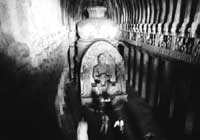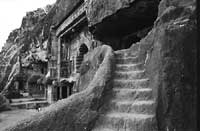|
|
||||
|
Discovering ancient sacred sites
where for |
||||
|
Scenes of Ajanta Caves |
First stop Bodhgaya: under the tree of enlightenment and tower of Mahabodhi. The sacred columns of Emperor Ashoka. Stops also at the stupas of Sarnath and Sanchi. The caves of Ajanta, Ellora and Khaneri Gopa carved into the rocks After leaving his ancestors’ palace to find a solution to human suffering, Prince Siddhartha Gautama, spent five years meditating in the forest and in vain sought the much hoped for answer in physical mortification. As he reached the very limit, he decided to give up the fast and, looking for a quiet place, sat under an enormous tree; there he immersed himself in a night long meditation. It is in this very place, in Bodhgaya, in the Northern Indian state of Bihar, at the foot of this beautiful tree clad in heartshaped leaves - which Western botanists named «Ficus Religiosa» and Buddhists «Bodhi Tree» -, that Siddhartha became Buddha, the Awakened One; he who understood that only the Middle Way can lead to Enlightenment. In Bodhgaya today, this tree still stands, even if it is a descendant of the one which sheltered the Buddha; it has become an object of veneration for all pilgrims. Emperor Ashoka (second century AC) to whom we owe the great flourishing of Buddhism and its sacred art in India, had the Bodhi tree surrounded with a beautiful stone sculptured balustrade, today exhibited in the local museum after it was substituted by a copy. The site of Bodhgaya is dominated by the great tower of the Mahabodhi temple, some fifty meters high, which most probably also dates back to Ashoka and was already described by the Chinese pilgrim Hiuen Tsang in the seventh century. Bodhgaya is still filled with spirituality, animated by monks coming from all Buddhist countries worldwide. Sarnath in the state of Bihar, is situated a few miles from Benares, which already during Buddha’s lifetime (sixth century AC), was one of the most important cities in India. The Deer Park in Sarnath sheltered many yogis and hermits, protecting them from the city’s confusion. Here Buddha, gave his first teachings, known as the «first turning of the wheel of Dharma». On that very site, a Stupa stands which goes back to the times of Emperor Ashoka. Sarnath was abandoned during the Muslim invasions which took place in the thirteenth century. This site, which today is much visited, was rediscovered by British architects in 1836. The museum houses the well known column of Ashoka, over twenty meters high and flanked by four lions, which today is the symbol of the Indian Nation and is an example of the extraordinary greco-buddhist art which reached India and Pakistan as a result of Alexander the Macedonian’s invasions. From Bhopal, capital of Madhya Pradesh, by crossing the fascinating countryside, one reaches Sanchi, a village holding the most important and best kept testimonies of Indian Buddhist art: the great and famous stupa, built by Ashoka, which measures some thirtyfive meters in diameter and sixteen meters in height, comprising four monumental stone doors, magnificiently sculptured, with panels depicting the life of Buddha and some of his precious previous lives. Nearby, there are other smaller stupas, just as beautiful. Then we come to what is known as the meditators’ India, the holy Buddhists who would retreat into caves to follow in their masters’ footsteps. The sites of Ajanta, Ellora and Khaneri Gopa are alone worth a journey. They are witnesses to over one thousand years of spirituality and art without compare and can be reached both from Aurangabad and Mumbai (Madhya Pradesh). The rocky Monastery of Ajanta is made up of thirty caves dug out in the mountain, thirty huge caves sculptured by man in volcanic stone between the second century BC and the fifth century AC. Like other Buddhist sites, Ajanta was abandoned as a result of the Muslim invasions: gradually the caves became solely a refuge for cobras and panthers, the entrances were hidden by vegetation and lay forgotten. Until that is, 1819, when some British soldiers discovered the entrance to one of these underground halls. There are two kinds of caves: the vihara or monasteries, which were inhabited by monks and consisted of great square halls with access to the cells; and the caitya or temples. The marvellous mural paintings which remained miraculously almost intact owing to the centuries long closure of the caves, are today endangered owing to atmospheric agents; however, they are a unique testimony of the splendid pictorial art of ancient buddhist India. More colossal, richer and almost baroque compared with the Ajanta caves, are the thirty-four caves of Ellora. They open up at the foot of a mighty rocky chamber, stretching over a two kilometre arc, and used to house both Buddhist as well as Hindu and Jain meditators. Unearthed between the sixth and eighth century AC, they are rich in statues and stupas. Cave number sixteen is a stupefying sight: a room some one hundred meters long and forty wide was hollowed out in the rock, featuring an enormous thirty-three meter high stone block in the centre, representing Mount Kailash, the Tibetan mountain sacred to both Buddhists and Hindus. Less well known, yet filled with a most intense and special atmosphAere as if they were still inhabited by the ancient yogis, are the one hundred and nine Khaneri Gopa caves, some thirty miles outside Mumbai. These were hollowed out in the Black Mountain between the first and tenth century and evidence the union between the three buddhist traditions, known as Hinayana, Mahayana and Vajrayana. They contain temples, great halls and cells to house monks, with beautiful statues and stupas sculptured in the rock. There is even an astronomical observatory cell perched on the summit of the hill. Enrica Mazzi
Useful information for the trip
|
|||
|
|
||||



